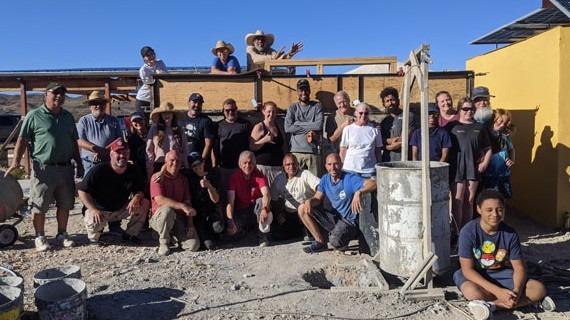Masses are discovering that they can afford a small home for under 20K Using Alternative Building Materials.


Alternative Building Methods like AirCrete help people build a home now and get sheltered asap. Some do it in financial emergencies. Some people build their tiny homes because they cannot afford rent or mortgage payments any longer. Typically people build a Timber Frame House. Other people with a thinking mind eventually reason that a house does not have to be a "normal" house. For thousands of years homes and cities were built out of mud and stone. Once one starts looking at what is possible and the beauty of ancient natural building materials is noticed. Then the floodgates of possibility open up. Earthship, cob, adobe, wool, hemp, straw clay slip, compressed earth bricks, straw bale, rammed earth, cast earth, ferrocement, caves, holes, trees.. The list goes on and the possibility becomes limitless. More information as well as video classes and hands on workshops can be found at https://tinygiantlife.biz
Many people build tiny houses they can afford for 10,000 to 100,000 dollars because it's cheaper than conventional homes. What they don't consider is that they are still stuck in the conventional matrix mindset and the cost of using so many manufactured goods when the global economy is crashing is very high. Instead, they could have chosen something different and built a larger more practical home for even less money.
This is where alternative building materials come into their strength. Tiny to small houses for under 10,000; 200 to 600 square feet. With careful planning and a reevaluation of the ways people live and what is actually necessary vs what is luxury and that which everyone is supposed to want according to society. One can create a plan and finish a very nice comfortable home.
So before considering one of those 10 Best Tiny Houses On Amazon for Under $20k. Consider that many of those are only half finished and have to be shipped. The cost of which will exceed the purchase price in most cases. Even those shipping container homes cost more than just building a barndominium. Which is going to have a better resale price? Life in a hallway is cramped and annoying over time. Many container homes are like this.
And don't even think about living in a yurt. Natives build those using animal and plant products using their hands for free. However, buying one will cost more than an alternative material house. Then, suffering from weather extremes is a problem. Also, the expense of large amounts of energy to maintain comfort is very large. Becoming more than the cost of the structure over a few years.
Now that brings up an important point with all the alternative buildings. What is the most energy efficient and comfortable? To answer that question let's cut to the chase. It's a building with thermal mass and insulation. Insulation on the outside and Aligned to the sun. Such a house must have a percentage of southern glass exposure equal to the latitude of the house site. Think of a brick house with brick on the inside and insulating walls on the outside. However, it's more expensive and more effort to have both. So, If choosing only one, it's best to choose insulation every time. Insulation allows for controlling of the temperature of the living space. It also lowers energy operating expenses over the lifetime of the house.
So, this leaves only insulating structures. Straw bale, hemp, Encapsulated polystyrene, AirCrete. Perhaps earthship building if it's a modern design with thick foam board around the earthen berm, but that thermal mass and insulation. Of course, one will have to choose between all-natural materials, a mix, or all factory-made.
To answer that let's consider what is affordable and available off the shelf right or out of the ground right now? Hemp is expensive and hard to source taking months to obtain. Straw can be hard to source also. Depending on location in relation to farmland. Shipping can be expensive over long distances. There's also often a waiting list. EPS is great, but shipping large containers of fluffy foam pellets is expensive. Finding and grinding trash is a long trashy process.
AirCrete on the other hand is made from portland cement inflated with air bubbles. This makes it insulating. Anywhere it's possible to locate, buy, haul, and use portland cement right now this day. So, anywhere water and a truck/trailer with a generator, a drill, a barrel, and a foam machine can go it's possible to build an alternative home asap. In as little as 2 weeks for tiny houses to complete in fact.
One worthy last mention is compressed earth bricks or cast earth. If modified and build with two walls 10 inches apart. The space can be filled with straw, big stem grass, foam trash, fiberglass, cellulose, or any insulating material and this forms a good modern-looking highly functional structure for the least possible money. Especially is built as an arch house saving the need for lumber roofing.
Visit to discover more:
https://tinygiantlife.biz/Workshop https://tinygiantlife.biz/VideoCourseComplete
https://tinygiantlife.biz/AirCreteIntroduction
https://tinygiantlife.biz/CaptureFreedom
